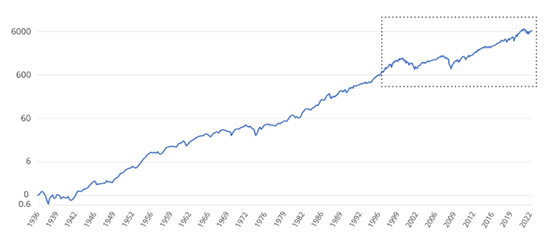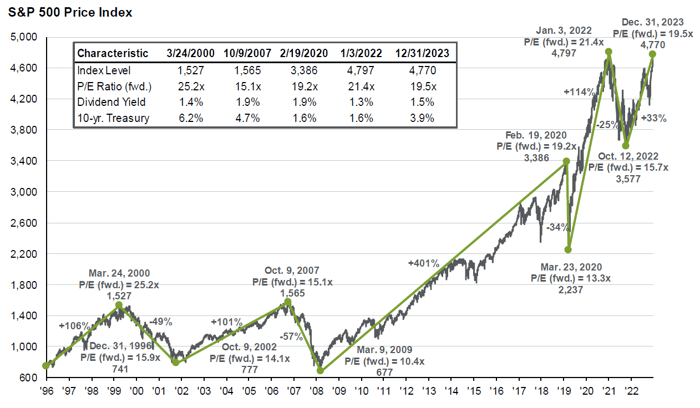
Strategically Deploying Your Capital
If you have a lump sum that you wish to invest, you have a choice. You can either invest it all at once, or you can invest it over time.
Dollar cost averaging is a strategy where you invest a set portion of your lump sum at regular intervals over a specified period.
For example, if you have $12,000 to invest, you might decide to invest $1,000 at the beginning of every month for the next year.
Dollar cost averaging is different than deciding to invest a set amount each month out of your paycheck or through a retirement plan like a 401(k) plan. Those strategies do not involve the investment of a lump sum of money over time.
When Should You Consider Dollar Cost Averaging?
You should consider dollar cost averaging if you are reluctant to invest your lump sum because:
- You are concerned that the stock market may decline after you do so
- You are wondering if now is the best time to invest—would another time be better?
The truth is no one knows how the stock market will perform in the short term and it’s impossible to perfectly time the market.
What is clear, however, is that over the long term, the stock market will rise. The graphic below shows the steady rise of the stock market, as represented by the S&P 500 Index, from 1936 through 2023.
Growth of the US Stock Market
1936-2023

US Stock Market as represented by the S&P 500 Index. Growth is shown on a logarithmic scale to more clearly highlight growth through history. Data Source: Morningstar
But it's not a consistent climb. The graphic below charts the S&P 500 Index at various inflection points between 1996 and 2023. As you can see, there are certainly periods along the way where the market declines—sometimes quite dramatically, such as during recent COVID-19 epidemic.
S&P 500 Index at Inflection Points
1996 - 2023

Source: JP Morgan Asset Management Guide to the Markets, U.S. 1Q 2024
But the important thing for long term investors is to put your money to work and take advantage of this historical upward trend of the stock market. Dollar cost averaging may be a useful tool for investors with a long investment horizon. Next, let's dive into the ways that dollar cost averaging can support investors' goals, and walk through an illustrative case study.
How Dollar Cost Averaging Can Help
Dollar cost averaging can help you get started putting your money to work in the stock market.
It does so in a number of ways:
- Dollar cost averaging reduces the emotion surrounding the investment decision by transforming it into a mechanical process. Otherwise, some investors may be frozen with indecision as they contemplate the possibility of a market decline after they invest.
- By employing a rules-based approach, dollar cost averaging eliminates the temptation to time the market. Even professional investors have a poor record of guessing the direction of the market.
- Dollar cost averaging can help you move forward with your investment by reducing the perceived risk and subsequent regret associated with a decline in the market after you invest. Yes, the market may decline, but it will only affect a portion of your total lump sum.
- By incrementally investing a portion of your lump sum and leaving the remainder in cash (or other low risk investments), the volatility of your portfolio will be reduced. The cash will dampen the ups and downs of the portion of your portfolio invested in stocks.
In all, dollar cost averaging can help you move forward with your investment plans, it may reduce the anxiety associated with doing so, and it has the potential to reduce overall portfolio volatility.
How Dollar Cost Averaging Works
Here is an example of how dollar cost averaging works. In this example, the investor invests $6,000 on a monthly basis over a period of six months.
| Time | Amount Invested | Share Price | Shares Purchased |
| Month 1 | $1,000 | $5 | 200 |
| Month 2 | $1,000 | $4 | 250 |
| Month 3 | $1,000 | $2 | 500 |
| Month 4 | $1,000 | $4 | 250 |
| Month 5 | $1,000 | $8 | 125 |
| Month 6 | $1,000 | $10 | 100 |
| Total Invested: $6,000 | Average Cost: $4.21 | Total Shares: 1,425 |
Because the market declined significantly after the initial investment and then rose significantly over the six-month investment period, this investor ended up with a relatively favorable outcome.
The share price was $5 at the time of the initial investment, but because the market subsequently declined, the investor’s average share price was only $4.21. Because the market later rose significantly, the original $6,000 investment is now worth $14,250.
If the investor had invested the entire $6,000 in Month 1, they would have had 1,200 shares worth only $12,000—a nice gain, but with dollar cost averaging the result was even better.
However, this favorable outcome is highly dependent on the return pattern used in the example. Here’s another example where the outcome is very different:
| Time | Amount Invested | Share Price | Shares Purchased |
| Month 1 | $1,000 | $5 | 200 |
| Month 2 | $1,000 | $6 | 166.67 |
| Month 3 | $1,000 | $8 | 125 |
| Month 4 | $1,000 | $7 | 142.86 |
| Month 5 | $1,000 | $6 | 166.67 |
| Month 6 | $1,000 | $5 | 200 |
| Total Invested: $6,000 | Average Cost: $5.99 | Total Shares: 1,001.20 |
In this example, the market rose initially and then declined to the original price of $5 per share. The investor who used a dollar cost averaging strategy ended up with an average share price of $5.99 and 1,001.20 total shares worth $5,006. The lump sum investor paid $5 per share and ended up with 1,200 shares worth $6,000. The lump sum investor is better off in this scenario.
How Effective is Dollar Cost Averaging?
The number of scenarios you could imagine are endless and the results of each one would be different. In a hypothetical world where market declines and increases are perfectly random, dollar cost averaging could produce as many favorable results as lump sum investing.
However, market movements are not random. The stock market tends to rise more often than it declines. It depends on the period you look at, but over the long term the stock market rises:
- 54% of the time on a daily basis
- 65% of the time on a monthly basis
- 70% of the time on an annual basis
In a world where the market tends to rise more than it declines, lump sum investing is likely to produce better returns over time than dollar cost averaging. The odds of upward market movement are simply greater, which favors the lump sum investor. However, there is more to the story in reality.
What Are the Benefits of Dollar Cost Averaging?
If the odds favor the lump sum investor in terms of performance, why would anyone consider dollar cost averaging? There are several compelling reasons:
- Dollar cost averaging helps reduce the anxiety that can be associated with investing a lump sum when the future direction of the market is uncertain (as it always is).
- Dollar cost averaging gets the investment process started, reducing the possibility of fear-based inaction.
- Dollar cost averaging can help avoid the temptation to time the market—an impossible task.
- Dollar cost averaging can minimize perceived risk and possible regret since each investment is smaller and investments are spread out over time.
- If the market does, in fact, decline soon after an investment is made, the average cost per share purchased may be reduced, allowing the investor to buy shares “on sale.”
- Dollar cost averaging reinforces the practice of investing regularly.
The benefits of dollar cost averaging are primarily behavioral, rather than returns based. But overcoming behavioral obstacles is important in the success of a long-term investment program.
If you consider dollar cost averaging, check the impact of transaction costs on that decision. In some cases, periodic investing may result in higher transaction costs than lump sum investing.
Tech-enabled Trading Tools
GeoWealth's proprietary trading order management system, what we call our Service Center, makes dollar cost averaging simple. If you would like to learn more about how to leverage our tech-enabled trading suite, schedule your one-on-one consultation with our team.
Discloures
The information contained herein does not constitute investment advice or a solicitation. This article is for dissemination of general information only. Information presented is believed to be factual and up-to-date, but we do not guarantee its accuracy and it should not be regarded as a complete analysis of the subjects discussed. Investments are not guaranteed and are subject to investment risk, including possible loss of the principal amount invested. Past performance is no guarantee of future results.
Get Powered by GeoWealth:
Jen Wing
Jen Wing is GeoWealth's Chief Investment Officer and is the Head of our Investment Committee. Jen received her MBA (Masters in Business Administration) from The Wharton School at University of Pennsylvania. She received her BS in Finance from The Smeal College of Business at The Pennsylvania State University. She also holds a Series 65 designation.
